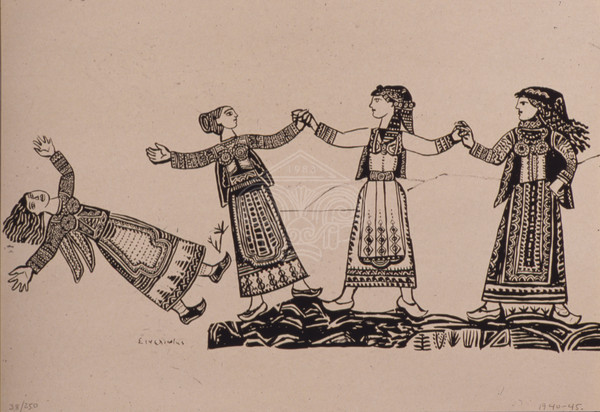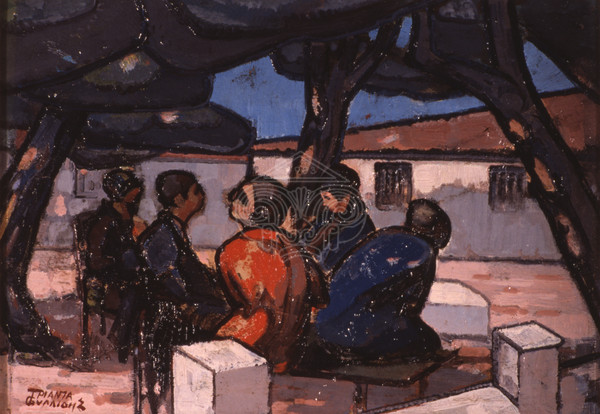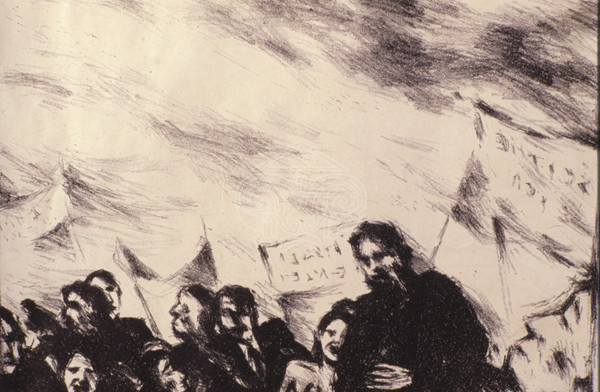
The latest addition to SearchCulture.gr, the national cultural content aggregator developed by the National Documentation Centre (EKT), is an exceptional art collection, that of the Municipal Art Gallery of Larissa - GI Katsigras Museum. 830 records of modern Greek art are now available to everyone for study, reflection and enjoyment.
The collection of the Municipal Art Gallery of Larissa includes, in particular, paintings and engravings from the mid-19th to mid-20th century, representative of the trends and explorations of modern Greek art. The wide array of works of the collection illuminates the view and the rationale of the donor Georgios Katsigras, a doctor and an educator, a resistance fighter and collector of works of art, who bequeathed it to his place of origin as a valuable legacy for the aesthetic education of the local community.
Not only does the collection illustrate with particular sensitivity aspects of daily life, but also the human struggle and spirit in difficult times such as the Occupation and the Resistance. Landscapes of Greek mountains and plains along with seascapes make up a large part of the collection, as well as portraits, female nudes, genre paintings and still lives.

Souliotisses, Sikeliotis Yiorgos (1917-1984), CC BY-NC 4.0
With the oldest work in the collection (which is also the first work acquired by the collector, a portrait of his great-grandmother) dating back to 1839 and the latest works from the 1980s, the collection spans about a century of Greek art history.
The collection has works starting from the Heptanese School (Georgios Avlichos, Kantounis Nikolaos), followed by the School of Munich, which represents academic tradition in this country, with artists such as Georgios Iakovidis, Nikolaos Gyzis, Polychronis Lembesis , the orientalist Symeon Savvidis and the seascape painter Konstantinos Volanakis.
Early 20th century European art trends arrive in Greece and are expressed mainly through landscape paintings of artists studying in Paris. Two examples include the two Greeks of the diaspora: Constantine Maleas who was born in Constantinople, represented in the collection by several of his landscapes, and the Alexandria-born Konstantinos Parthenis. Both were members of 'Techni Group' (Omada Tehni Art Group), like Nikolaos Lytras, and the lesser known, but excellent artist Theophrastos Triantafyllidis. These pioneers import contemporary European art trends, such as symbolism and painting of the Nabi- rather than Impressionism, who did not work well given the sharp constrasts and brightness of Greek light- yet manage to infuse them them a local "dialect".

Daytrip in Galatsi, Triantafillydis Theofrastos (1881-1955) CC BY-NC 4.0
Soon after the Asia Minor Disaster and alongside their literary counterparts, the 'Generation of the '30s' emerges. Nikos Hadjikyriakos-Ghikas, Polykleitos Regkos, Nikos Nikolaou, Giorgios Gounaropoulos and Agenor Asteriades, from Katsigra’s home city, Larisa, weave indigenous sources of inspiration drawing from the Byzantine, ancient Greek and folk tradition, with the modernistic idioms that are so fashionable in Europe.
Younger artists, such as Giannis Moralis and Giannis Psychopedis, capture the essence of the place, but also testimonies of memory and history, as does the engraver Tassos (Anastasios Alevizos). An outstanding album containing 16 woodcuts, was inspired by the poem of Dionysios Solomos 'The destruction of Psara'. Tassos focused on wood engraving as he considered woodcuts to be the art of the people.

Protest, Psychopedis Yannis (1945-) CC BY-NC 4.0
The collection also features the generation of resistance artists: engravers such as Giannis Kephallenos, Vaso Katraki and Antonis Kanas, who created a series of lithographs inspired by the Occupation, and painters such as Valias Semertzides and Dimitris Gioldasis, who are represented in the collection with portraits and landscapes from their later period, especially of Gioldasis, who is the artist mainly associated with images of the wide Thessalian plains. Because of the friendship linking the painter and the collector, the collection features much of his work including a portrait of G.I. Katsigras himself.
Art in the digital public space
Through partnerships such as this, SearchCulture.gr continues to increase its available art content. The collection of the Municipal Art Gallery of Larissa together with the collections of the National Gallery, the E.Averof Gallery, the Frissiras Museum, and other art collections, create an invaluable body of content of thousands of artworks. The value generated in the digital public space through the aggregation of visual content is immense. Aggregation brings together virtually the whole body of work of Greek artists and offers possibilities for new discoveries, links and relationships between their work and other artists’ work, across the centuries, mapping the paths that art in Greece has taken throughout its long journey.
Municipal Art Gallery of Larissa-G.I.Katsigras Museum
Municipal Art Gallery of Larissa-G.I.Katsiga Museum is a cultural organisation promoting the visual arts. It was founded in 1983 and features the collection of 780 works of art donated to the Municipality of Larissa in 1981 by George I. Katsigras. The works of the Collection chronologically cover a substantial period of modern Greek painting and engraving and are exhibited in the Museum organised in themes such as 'The spirit of the place', 'Ideal Creatures', 'Intimacy' and ‘Resistance’ proposing a new narrative for the place and its people in the historical evolution of the relations between them. The Collection also includes some of the personal items of the archaeologist of Troy and Mycenae, Heinrich Schliemann. The donation was accompanied by 1,000 volumes of illustrated books, with biographies of Greek and foreign painters, sketches and photographed works. Georgios Katsigras is considered a benefactor of the city of Larissa, a great model of a patriot and an art lover.
* Key photo: Porta Panayia bridge Yoldasis Dimitris (1897-1993) CC BY-NC 4.0
















